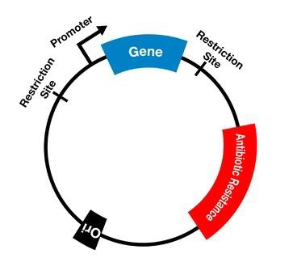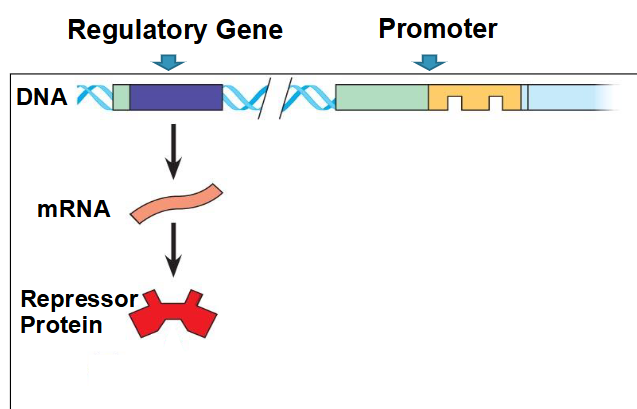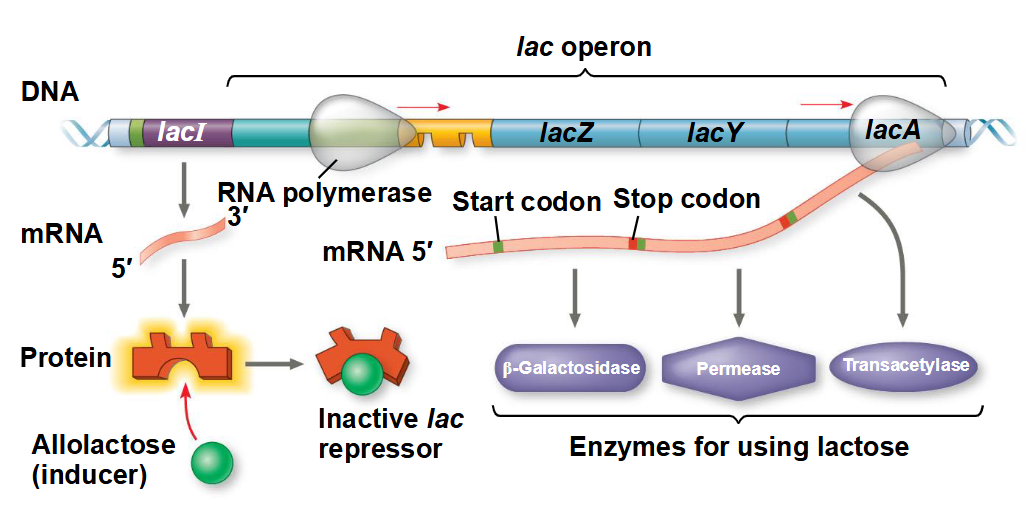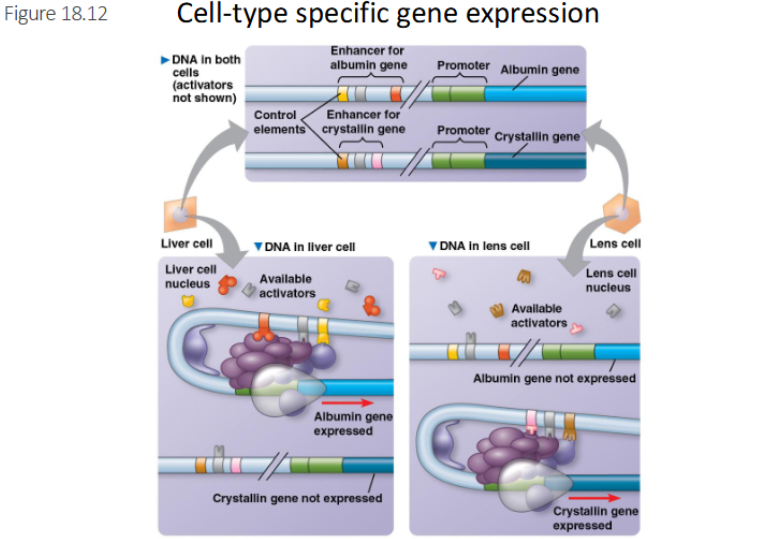Integrative Biology - Chapter 18 (Regulation in Prokaryotes)
1/72
There's no tags or description
Looks like no tags are added yet.
Name | Mastery | Learn | Test | Matching | Spaced |
|---|
No study sessions yet.
73 Terms
Plasmids
Extra-chromosomal DNA; a plasmid is a small ring of double-stranded DNA that carries “accessory” genes; separate from the main bacterial chromosomal; an origin of replication; can replicate separaretly

What are two operons?
trp Operan and lac Operan.
Repressor proteins can be synthesized in both active and inactive form.
True
What does “trp” stand for?
Tryptophan
Tryptophan is normally…
“ON”
Gene expression can be “repressed”, which means it can turn…
“OFF”
The binding of the repressor protein to the operator is not reversible.
False
Corepressor
Binds to the repressor protein to change it’s shape so it can fit.
The three functions of tryptophan are…
bind, change shape, block.
In prokaryotic gene regulation, which of the molecule is a protein produced by a regulatory gene?
Repressor.
Where does regulations start in bacteria?
At the level of transcription intiation. They have a less complex regulation system.
What is the operon made of?
The operator, the promoter, and the genes that are transcribed.
In connection with operons, the regulatory gene codes for the ____________.
repressor protein.
What happens if a repressor protein binds
to the operator first?
The gene is not expressed. RNA polymerase is blocked from the promoter.

Where does the repressor protein come from?
A regulatory gene produces the repressor protein.

What is a lac operon?
A type of inducible operon.
How does the lac operon turn on?
A molecule called an inducer (allolactose) inactivates the repressor to turn the lac operon on.
The inducer binds the repressor protein, altering
its shape of the repressor so it can no longer
bind to the operator sequence.

What is negative gene control?
Switched “off” by activating the form of the repressor molecule.
Where are operons found?
Common in bacteria but not found eukaryotes.
Why is gene expression in eukaryotes more complicated?
Genome size is larger, chromatin is extensive and organized.
Co-expressed genes are typically scattered over different chromosomes; co-expression involves chemical signals.
What is epigenetics?
The study of changes in gene expression
that are heritable, but do NOT involve
changes to the DNA sequence
Chromatin Remodeling involves…
Protein complexes moving or ejecting nucleosomes
Chromatin Modification
Covalent changes to amino acids in histone tails. Whether that’s adding or removing amino acids.
Acetylation always occurs with…
actively expressed genes.
DNA Methylation is…
adding an accessory/costume to the DNA. In this case, methane.
Where does most regulation occur in eukaryotes?
Transcription initiation
Chromatin Modifiers
Enzymes that add groups of DNA to amino acids and the histone tails.
What’s the first thing that occurs in Transcription for eukaryotes?
Transciption facotrs bind to the TATA box
What starts up initiation and mRNA synthesis?
The interaction of general transcription factors and RNA Polymerase II with a promoter. Generally only at a slow basal rate.
What are Control Elements?
Sequences of non-coding DNA that help regulate transcription by binding other proteins.
_________________ are close to the promoter
Proximal Control Elements
__________________ are more distant from the promoter.
Distal control elements
Groupings of distal control elements are called ___________________.
Enhancers
Enhancers are regions of DNA molecule; they are not genes
True
What are two different types of specific transcriptipon factors?
Activator and repressor proteins
Enhancers are ___________________ for proteins that act as specific transcription factors.
binding sites
Activators are…
transcription factors that bind to an enhancer and stimulates transcription of a gene
How many domains do activators have?
One that binds DNA and second that activates transcription.
What must occur for the initial remodeling/modification of Chromatin?
Nucleosomes are reposition.
Histone tails are modified
Transcription Initiation
Activators must be expressed, and the ability to bind to enhancers. The ability to bind to promoter.
Describe what’s occurring in cell-type specific gene expression .
Explain…

Which nucleotide is methylated in DNA?
Cytosine. It’s methylated in DNA Occurs when a cytosine is next to a Guanine.
When the CpGs (Cytosine-phosphate-Guanine) in a promoter are methylated the gene is usually turned OFF.
True
Why is euchromatin better for transcription initiation?
The loose structure makes it easier for tf to bind to the promoter.
nucleo-i
composed of rna to do translation
In a prokaryotic inducible operon (ex. lac operon), which of the following molecules binds to a repressor so that the repressor no longer binds to an operator?
inducer
A prokaryote's ability to regulate patterns of gene expression most likely promotes the organism's survival by ________.
Allowing an organism to change in it’s environmental conditions.
Which of the following best explains why a neuron and a pancreatic cell isolated from the same individual contain different proteins, have different morphologies and perform different functions?
The set of genes in each cell is different… so they express different proteins and different functions.
Which of the following processes degrades mRNA molecules after transcription if they have a sequence complementary to a small non-coding RNA?
RNA interference
Which of the following statements correctly describes a characteristic of tumor-suppressor genes?
They encode proteins that help regulate the cell cycle prevent uncontrolled cell growth.
X chromosome inactivation means that.....
an entire X chromosome is turned OFF in all cells
How many non-coding RNA exist in the human genome?
98%.
microRNAs are acronmyed for…
miRNA
Small interfering RNAs are acronymed for…
siRNAs
what is RNA interference acronymed for?
RNAi
What is RN
A post transcriptional level of regulation. Messenger RNAs can be made but are either degraded, chopped up, or translation into protein will be blocked.
What are miRNAS?
Small non-coding RNAs that’ll form a complex with a special set of proteins that will then bind to target mRNA and destroy them. Single stranded.
The complex together is called and does…
RISC (RNA-induced silencing complex)
(RISC) - If miRNA and the target mRNA are complementary for all bases, the target mRNA will be ________________________.
…chopped up by the RISC complex.
(RISC) If there’s a mismatch (not completely complementary), then translation is ______________________________.
…blocked on the target mRNA. It can’t be translated by a ribosome
What’s the protein that chops up microRNA?
Dicer
How does the RISC complex work?
Dicer cuts up the microRNA. mRNA and miRNA are produced.
The cut up miRNA will then denature and complex with the RISC.
The remaining mRNA’s bases are all complementary and would begin degrading/chopping up of the mRNA.
miRNA has some complementary amongst the bases, but isn’t completely complementary. There would be bases that don’t form hydrogen bonds. Rather than being chopped up, it blocks translation. The ribosome would run into a big chunky RISC and block translation of the full transcript.
What are long ncRNAs? (long non-coding RNAs)
Longer than 200 base pairs in length.
Contains XIST and is a gene that codes for X-chromosome inactivation in females.
How does cancer relate to genetic expression?
Cancer results from the genetic/epigenetic changes that affect the control of cell growth and the cell cycle.
The cells just keep proliferating and amplifying.
Usually related to the expression of genes.
What are Proto-oncogenes?
“Normal” version of genes that code for proteins involved in normal cell growtth and division.
What are Oncogenes?
Genes that have been changed by mutation or are over-expressed, so their version is the same gene but they don’t regulate cell growth and division. They don’t function the way they should. They’re “cancer-causing” versions.
How do Proto-oncogenes transform into oncogenes?
Epigenetic changes
Translocation or transposition (Changes within the genome)
Gene amplification; if we make more copies of a certain gene in the cell, then we get more protein and that can cause the effects
Point mutations
Where can we have point mutations occur?
Point mutations within a control element (promoter or enhancer) causing increased expression
Point mutations within a proto-oncogene that changes that gene’s product to a protein which is more active or more resistant to degredation.
What are Tumor-supressor genes?
A gene in which their products/protein inhibit uncontrollable cell division. They help prevent uncontrolled cell division.
Anything that decreases their normal levels/activity may contribute to cancer.
What do Tumor-suppressor proteins normally do?
Repair damaged DNA
Control cell adhesion
Act in cell-signaling pathways that inhibit the cell cycle
What are CpG islands?
Clusters of Cytosine and Guanines right next to each other.
How can cancer be caused?
They’re spontaneous or inherited
Caused by exposure to physical and chemical agents
Caused by viruses
Viruses can contribute to cancer development… by integrating their genetic material into the DNA of infected host cells, what can they do?
Convert a proto-oncogene
Introduce an oncogene
Disrupt a tumor-suppressor gene